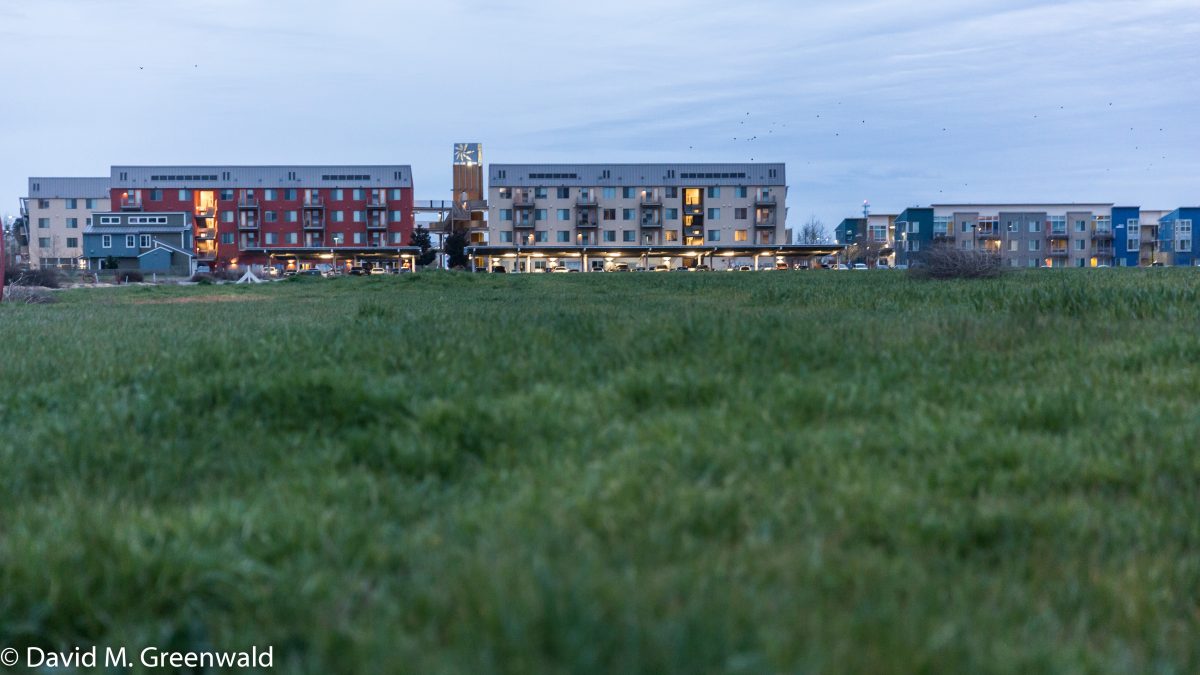
This week, UC Davis approved a budget and design for replacement of Emerson Hall, a residence hall at the University of California, Davis. They also received an overview of UC Davis’ plans for student housing, including planned projects at Orchard Park and West Village.
According to a release, “UC Davis is implementing the most ambitious student housing and dining plan in its history.” Here the strategy is “university-owned first-year residence halls with public-private development to deliver apartment-style housing for upper division and graduate students.”
UC Davis announced that the campus will add approximately 5200 student beds over the next six years. That would ostensibly leave another 2300 beds over the final four years of the Long Range Development Plan (LRDP) to meet their 8500 goal.
“The Emerson Replacement Project includes demolition of a 50-year old building and replacing it with three new buildings, one of five stories and two of four stories, with a total of 809 residence hall beds, said Emily Galindo, associate vice chancellor for Student Affairs.”
Emerson Hall is located in the Cuarto neighborhood just north of Russell Boulevard. The construction cost of approximately $109 million will be repaid over time through student residence fees.
According to the release, “The committee also discussed the planned housing developments at Orchard Park and West Village. UC Davis is currently negotiating with University Student Living to 
develop these projects.”
They are looking at 200 two-bedroom apartments for students with families at Orchard Park with another 1200 beds for single grad students at the same location.
For West Village, they are calling for 3800 new student beds which is in addition to the 2200 students already residing at that location.
The release stated: “Affordability is a key objective for both the Orchard Park and West Village projects.” The goal they said is “to set rents at levels significantly below market rates in the city of Davis.”
All four sites – Webster, Emerson, West Village and Orchard Park – projects are included in the LRDP for UC Davis.
“The LRDP designates site planning areas for further housing growth to accommodate 8,500 students living on campus. With each housing project, UC Davis explores options for maximizing affordability, increasing density and enriching community life,” they write.
“Through extensive public outreach, the draft LRDP balances community input with long-term planning to help meet the higher education needs of California. The environmental impact report for the LRDP will be available for public comment in early April.”
The commitment for rents below market rates in the city would mark a major point of departure.
As UC Davis moves forward with its commitment to add capacity, the Vanguard‘s analysis has shown that affordability questions remain. In our tour of Tercero, we saw the three-bed dorm room, small and cramped, and yet costing $950 each before meal plan.
Moreover, overall, according to UC Davis and UC statistics, UC Davis is the second most expensive campus for on-campus housing. It costs 60 percent more for a student to live on campus, versus off campus – where Davis, while impacted in terms of vacancy rate, is still the second least expensive place to live off-campus.
We see these factors at play in the occupancy rates for on-campus housing. The Vanguard has recently received the latest data and it shows an interesting polarity.
For residence halls, which, while not required, for the most part house the vast majority of freshman, the capacity for 2017-18 is listed at 5253 – but with occupancy maximized to two and three in a room at times, the occupancy is 5747. That puts the residence halls at 109 percent of capacity.
However, the campus apartments are a different story. Here, the apartments are largely competing with apartments throughout town. Overall, the vacancy rate for campus apartments is about at 7 percent. Not bad, but that is 175 times higher than the 0.4 percent vacancy rate for similar apartments in town.
But even that is a bit misleading, as places like the Colleges at La Rue is at 125 percent of capacity and Solano Park Apartments are at 110 percent of capacity.
Where UC Davis is struggling is with West Village. It is doing slightly better than last year, but is still at roughly 17 percent vacancy.
West Village accounts for 55 percent of the on-campus apartment capacity.
Adjusting rents would clearly help West Village and other on-campus apartments become more competitive with off-campus housing.
The city on Tuesday approved Lincoln40, following the approval of Sterling and Nishi, which is still pending a Measure R vote. If the city can add around 5000 to 6000 beds combined with the university’s 8500 commitment, it would go a long way toward solving the city’s housing crisis.
—David M. Greenwald reporting







Flag this in case people missed it: The goal they said is “to set rents at levels significantly below market rates in the city of Davis.”
I saw it. Yay! (I wonder why that wasn’t a goal all along.)
Maybe that will control the annual rent increases that renters are experiencing now.
I don’t think anything UC Davis does will stop rents from increasing since with some exceptions rents have been pretty much going up every year in thriving America cities for the past 100 years (along increases in the price of real estate, gas, electricity, insurance and taxes)…